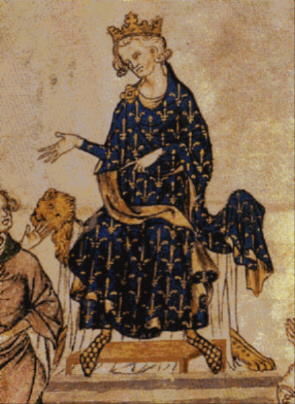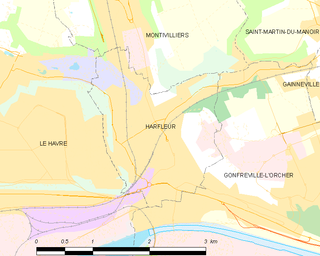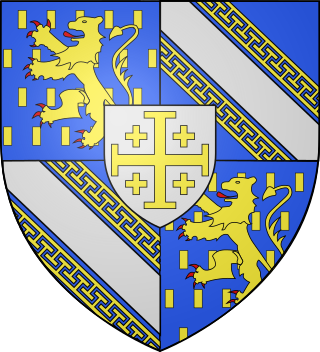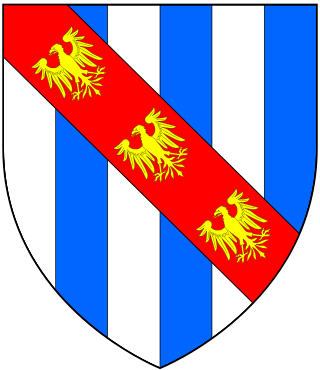
Charles II, known as the Bad, was King of Navarre beginning in 1349, as well as Count of Évreux beginning in 1343, holding both titles until his death in 1387.

Philip VI, called the Fortunate or the Catholic and of Valois, was the first king of France from the House of Valois, reigning from 1328 until his death in 1350. Philip's reign was dominated by the consequences of a succession dispute. When King Charles IV of France died in 1328, his nearest male relative was his nephew, King Edward III of England, but the French nobility preferred Charles's paternal cousin, Philip.

The siege of Harfleur was conducted by the English army of King Henry V in Normandy, France, during the Hundred Years' War. The defenders of Harfleur surrendered to the English on terms and were treated as prisoners of war. It was the first time that an English army made significant use of gunpowder artillery in the siege of a large urban settlement.

The siege of Calais occurred at the conclusion of the Crécy campaign, when an English army under the command of King Edward III of England successfully besieged the French town of Calais during the Edwardian phase of the Hundred Years' War.

The Battle of Winchelsea or the Battle of Les Espagnols sur Mer was a naval battle that took place on 29 August 1350 as part of the Hundred Years' War between England and France. It was a victory for an English fleet of 50 ships, commanded by King Edward III, over a Castilian fleet of 47 larger vessels, commanded by Charles de la Cerda. Between 14 and 26 Castilian ships were captured, and several were sunk. Only two English vessels are known to have been sunk, but there was a significant loss of life.

Raoul I of Brienne was the son of John II of Brienne, Count of Eu and Jeanne, Countess of Guînes.
The Battle of Lunalonge was fought in the summer of 1349 between a French force numbering approximately 1,500 men and an Anglo-Gascon force of some 500 men, during the first phase of the Hundred Years' War. The location of the battle is thought to have been modern Limalonges in Deux-Sèvres. The outnumbered Anglo-Gascons, commanded by Thomas Coke, gained the upper hand during the day, but had to withdraw on foot during the night because the French, under Jean de Lille, had captured their horses. The French lost approximately 300 killed and an unknown but large number captured, including their leader.

The Battle of Caen was an assault conducted on 26 July 1346 by forces from the Kingdom of England, led by King Edward III, on the French-held town of Caen and Normandy as a part of the Hundred Years' War.

The Battle of Pontvallain, part of the Hundred Years' War, took place in the Sarthe region of north-west France on 4 December 1370, when a French army under Bertrand du Guesclin heavily defeated an English force which had broken away from an army commanded by Sir Robert Knolles. The French numbered 5,200 men, and the English force was approximately the same size.

The Battle of Calais took place in 1350 when an English force defeated an unsuspecting French army which was attempting to take the city. Despite a truce being in effect the French commander Geoffrey de Charny had planned to take the city by subterfuge, and bribed Amerigo of Pavia, an Italian officer of the city garrison, to open a gate for them. The English king, Edward III, became aware of the plot and personally led his household knights and the Calais garrison in a surprise counter-attack. The French were routed by this smaller force, with significant losses and all their leaders captured or killed.
Blanchetaque is a former ford crossing of the River Somme, in the Somme department in Hauts-de-France in northern France. The name of the ford is derived from the white stones marking the way across the river. Saigneville was on the southern side of the ford, before the construction of the Canal de la Somme. The ford was the site of the Battle of Blanchetaque in 1346, during the Hundred Years' War, between an army of King Edward III of England and a French force led by Godemar I du Fay.

Sir John Harpeden was an English knight and administrator who served Edward III of England in France during the Hundred Years' War. He served as seneschal of Saintonge (1371–72) and seneschal of Aquitaine (1385–89). His descendants became French lords. He is called John Harpeden I or John Harpeden the Elder to distinguish him from his son, Jean Harpedenne II.
Jean Harpedenne II was a French aristocrat, administrator and military officer. He was the seigneur of Belleville and a Marmouset at the court of King Charles VI.
Sir Oudart I de Renti, Lord of Embry, Curlu, Affringues, and Vaudringhem was a French nobleman.

Thomas de Grandison, 4th Baron Grandison, KG, was an English soldier and nobleman.
Château de la Faigne was a castle in Pays de la Loire, France.
Château de Courcillon is a castle in Dissay-sous-Courcillon, Pays de la Loire, France.
The siege of Guînes took place from May to July 1352 when a French army under Geoffrey de Charny unsuccessfully attempted to recapture the French castle at Guînes which had been seized by the English the previous January. The siege was part of the Hundred Years' War and took place during the uneasy and ill-kept truce of Calais.
The Treaty of Guînes was a draft settlement to end the Hundred Years' War, negotiated between England and France and signed at Guînes on 6 April 1354. The war had broken out in 1337 and was further aggravated in 1340 when the English king, Edward III, claimed the French throne. The war went badly for France: the French army was heavily defeated at the Battle of Crécy, and the French town of Calais was besieged and captured. With both sides exhausted, a truce was agreed that, despite being only fitfully observed, was repeatedly renewed.
Lancaster's Loire campaign was the march south from Brittany in August 1356 by an English army led by Henry, Duke of Lancaster. He was attempting to join the army of Edward, the Black Prince, near Tours. The French had broken the bridges over the River Loire and Lancaster was forced to turn back, returning to Brittany in September.











